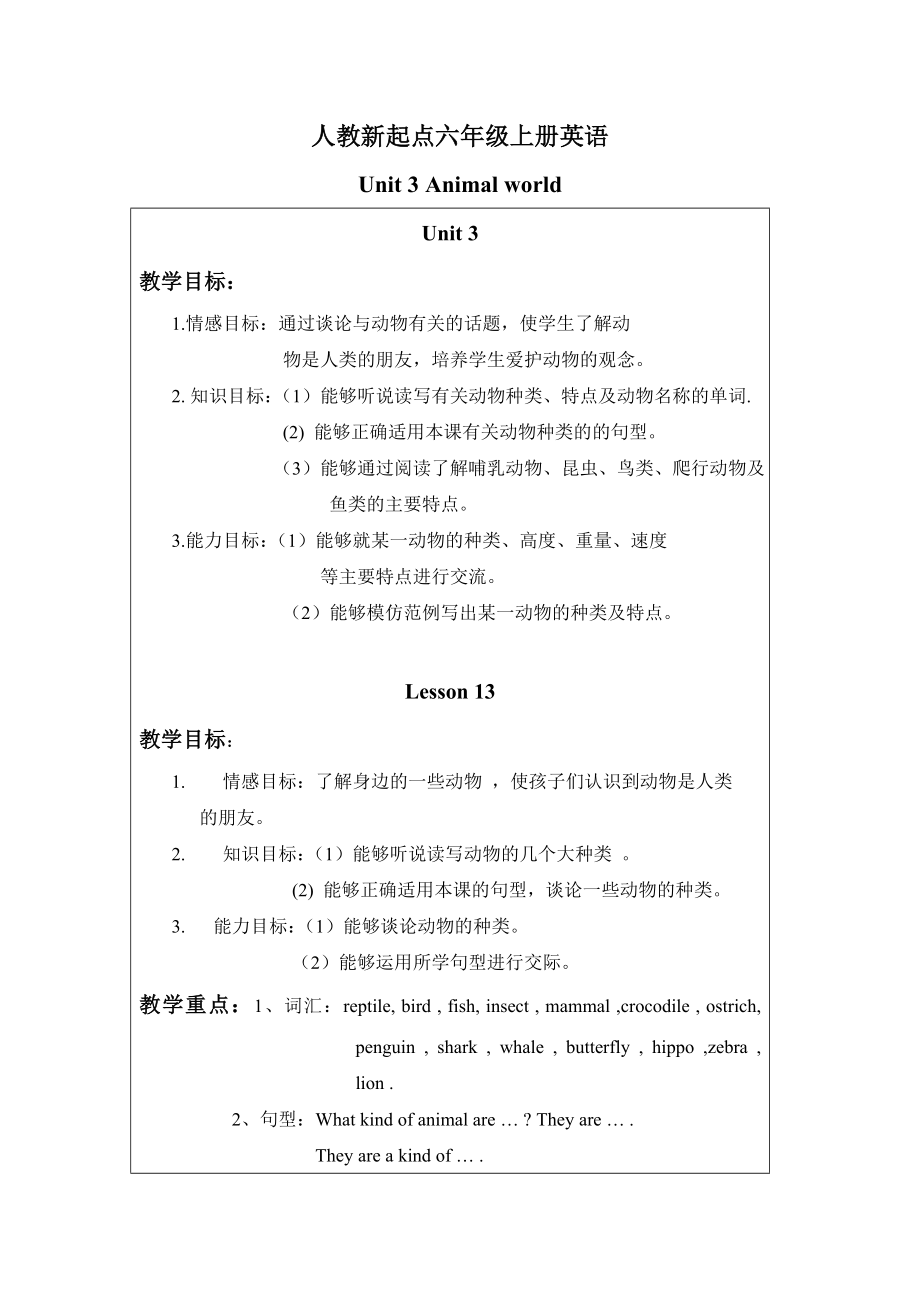《人教新起點(diǎn)英語(yǔ)六上《unit 3 animal world》(lesson 1314)word教案》由會(huì)員分享�����,可在線(xiàn)閱讀���,更多相關(guān)《人教新起點(diǎn)英語(yǔ)六上《unit 3 animal world》(lesson 1314)word教案(6頁(yè)珍藏版)》請(qǐng)?jiān)谘b配圖網(wǎng)上搜索���。
1�����、人教新起點(diǎn)六年級(jí)上冊(cè)英語(yǔ)
Unit 3 Animal world
Unit 3
教學(xué)目標(biāo):
1.情感目標(biāo):通過(guò)談?wù)撆c動(dòng)物有關(guān)的話(huà)題����,使學(xué)生了解動(dòng)
物是人類(lèi)的朋友�����,培養(yǎng)學(xué)生愛(ài)護(hù)動(dòng)物的觀念�。
2.?知識(shí)目標(biāo):(1)能夠聽(tīng)說(shuō)讀寫(xiě)有關(guān)動(dòng)物種類(lèi)�、特點(diǎn)及動(dòng)物名稱(chēng)的單詞.
(2) 能夠正確適用本課有關(guān)動(dòng)物種類(lèi)的的句型。
(3)能夠通過(guò)閱讀了解哺乳動(dòng)物�、昆蟲(chóng)、鳥(niǎo)類(lèi)�����、爬行動(dòng)物及魚(yú)類(lèi)的主要特點(diǎn)����。
3.能力目標(biāo):(1)能夠就某一動(dòng)物的種類(lèi)、高度、重量��、速度
等主要特點(diǎn)進(jìn)行交流�。
2、 (2)能夠模仿范例寫(xiě)出某一動(dòng)物的種類(lèi)及特點(diǎn)����。
Lesson 13
教學(xué)目標(biāo):
1.?????? 情感目標(biāo):了解身邊的一些動(dòng)物 ,使孩子們認(rèn)識(shí)到動(dòng)物是人類(lèi)的朋友�����。
2.?????? 知識(shí)目標(biāo):(1)能夠聽(tīng)說(shuō)讀寫(xiě)動(dòng)物的幾個(gè)大種類(lèi) ����。
(2) 能夠正確適用本課的句型,談?wù)撘恍﹦?dòng)物的種類(lèi)���。
3. 能力目標(biāo):(1)能夠談?wù)搫?dòng)物的種類(lèi)����。
(2)能夠運(yùn)用所學(xué)句型進(jìn)行交際�。
教學(xué)重點(diǎn):1、詞匯:reptile, bird , fish, insect , mammal ,cro
3����、codile , ostrich, penguin , shark , whale , butterfly , hippo ,zebra , lion .
2�����、句型:What kind of animal are … ? They are … .
They are a kind of … .
教學(xué)難點(diǎn):1�����、較難掌握的詞匯�。
2�、模仿范例說(shuō)出自己所喜歡的動(dòng)物的種類(lèi)和特點(diǎn)。
教具準(zhǔn)備:錄音機(jī)��、磁帶�����、 卡片 �、圖片
教學(xué)過(guò)程:
教學(xué)步驟
教師活動(dòng)
學(xué)生活動(dòng)
反思
1.
2.
3.
4.
4���、
5.
6.
7.
8.
Show an animal in hand, and ask what is it ?
Have you ever been to Animal World ? What animals did you see at Animal World ? What animals do you like ?What do you look like ?
Show a picture and ask :
What animals do you see in the picture ? Teach the new
5�����、 words .
What kind of animal are … ?
Teach the words : mammal \insect \ reptile \
Play the recorder ,and then lead the students to finish the exercise A
Check the answer and call a students to report in the class .
Let the students to read after the tape .
Call some students to rea
6����、d the passages .
Look at the animal and answer the teacher’s question .
Answer the questions and think about .
Answer and learn the new words .
They are … .
Learn the new words .
Listen to the tape and finish Part A .
Check the answer and report .
Read after the tape
7、.
Read by themselves .
Lesson 14
教學(xué)目標(biāo):
1. 情感目標(biāo):了解不太熟悉的一些動(dòng)物 �,使孩子們有個(gè)初步的認(rèn)識(shí)。了解
他們的特點(diǎn)����。
2.?????? 知識(shí)目標(biāo):(1)能夠聽(tīng)說(shuō)讀寫(xiě)本課的動(dòng)物名稱(chēng) 。
(2) 能夠正確適用本課的句型��,談?wù)撘恍﹦?dòng)物的種類(lèi)及特點(diǎn)�。
(3)掌握句型 as …as 的用法。
3 能力目標(biāo):(1)能夠談?wù)搫?dòng)物的種類(lèi)���。
(2)能夠填寫(xiě)動(dòng)物卡片 �。
教學(xué)重點(diǎn):1����、詞匯:hummingbird
8、, centimeter , kilometer , giraffe 的發(fā)音����,及書(shū)寫(xiě)�。
2�、句型:What kind of animal are … ? They are … .
They are a kind of … .
教學(xué)難點(diǎn):1、較難掌握的詞匯����。
2、用 as …as 句型結(jié)構(gòu)來(lái)描述動(dòng)物的某一特點(diǎn)�。
教具準(zhǔn)備:錄音機(jī)、磁帶���、 卡片 �、圖片
教學(xué)過(guò)程:
教學(xué)步驟
教師活動(dòng)
學(xué)生活動(dòng)
反思
1.
?
?
2.
?3.
?
3.
4.
4.
9����、
5.
6.
Review :
Show a picture ,and ask
How many animals do you see in the picture ? what are they ?What kind of animal are they ?
Where do they live ?
Show another picture ,and ask what animal are they ? Teach the new words . hummingbird / ostrich /whale
Practice the words and l
10、ead the students to read them .
Lead the students to open the book and talk about the pictures and information cards in groups.
Ask the students :
Where is … from ?
How tall is it ?
Is it as tall as a … ?
How heavy is it ?
How fast is it ?
Teach the sentences and new words .
Play t
11��、he recorder and let the students to complete the blanks .
Check the answer .
Look at the picture , and answer the question .
They live on the land / in the water .
Look at the picture and learn the new words .
Read the words after teacher .
Look at the pictures and complete the inf
12��、ormation cards in groups.
Answer the questions ?
And learn the sentences and new words .
Listen to the tape and complete the blanks .
Check the answers.
小貼士:小學(xué)英語(yǔ)教學(xué)
英語(yǔ)學(xué)習(xí)��、英語(yǔ)教學(xué)越來(lái)越受到人們的普遍重視�。隨著時(shí)代的發(fā)展和社會(huì)的進(jìn)步���,英語(yǔ)
已從一種工具變成了一種思想��,一種知識(shí)庫(kù)����。沒(méi)有掌握英語(yǔ)猶如缺乏一種思想,缺少了一個(gè)
重要的知識(shí)源泉���?���?梢赃@樣說(shuō)�,學(xué)會(huì)英語(yǔ),不但多了一雙眼睛���,
13���、一對(duì)耳朵,和一條舌頭��,甚
至是多了一個(gè)頭腦����!因?yàn)檎Z(yǔ)言是人類(lèi)思維的工具����,認(rèn)識(shí)世界的工具����,掌握一種語(yǔ)言也即掌握
了一種觀察和認(rèn)識(shí)世界的方法和習(xí)慣。
從日常工作中的點(diǎn)點(diǎn)滴滴����,總結(jié)以下幾點(diǎn)反思:
一、靠持續(xù)不斷的語(yǔ)言知識(shí)���,而不是"玩"來(lái)培養(yǎng)學(xué)生持久的興趣
小學(xué)英語(yǔ)教學(xué)是要重視培養(yǎng)興趣�����,但單靠唱歌游戲不能培養(yǎng)學(xué)生持久的興趣��。新鮮勁兒
一過(guò)����,孩子們就會(huì)厭倦���。所以�����,唱歌游戲應(yīng)該作為小學(xué)生學(xué)習(xí)英語(yǔ)語(yǔ)言知識(shí)�、技能的一些手
段���,而不是培養(yǎng)興趣的手段����。我們可以采用多種手段幫助小學(xué)生在記憶力強(qiáng)的時(shí)期多記單詞�,
多學(xué)習(xí)語(yǔ)言規(guī)則,并盡可能多創(chuàng)造模仿的機(jī)會(huì)���,提高學(xué)生的語(yǔ)音
14����、和語(yǔ)調(diào)�����。在英語(yǔ)學(xué)習(xí)中����,聽(tīng)���、
說(shuō)、讀�����、寫(xiě)��、譯五種能力是可以互補(bǔ)的�。真正做到聽(tīng)說(shuō)先行,讀寫(xiě)跟上��。光聽(tīng)說(shuō)不讀寫(xiě)���,很
難收到高效��。只靠模仿不培養(yǎng)學(xué)習(xí)能力����,也難減輕學(xué)習(xí)負(fù)擔(dān)��。所以小學(xué)生還是應(yīng)當(dāng)認(rèn)真進(jìn)行
語(yǔ)言學(xué)習(xí)���。
二����、英語(yǔ)應(yīng)用能力需要相應(yīng)的詞匯。
而目前在小學(xué)的低年級(jí)的英語(yǔ)教學(xué)中����,不要求學(xué)生掌握詞匯�,而只要求學(xué)生能根據(jù)提示
或圖片說(shuō)出該單詞,其本質(zhì)無(wú)非是要學(xué)生們死記硬背����,鸚鵡學(xué)舌。由于小學(xué)生們沒(méi)有相應(yīng)的
讀音規(guī)則訓(xùn)練��,不熟悉詞匯的拼寫(xiě)規(guī)則�,單詞的音、形�����、意三者不能有效的結(jié)合在一起��,因
而導(dǎo)致了單詞記憶的困難�,并成了小學(xué)生學(xué)英語(yǔ)的困難。
三、努力培養(yǎng)學(xué)習(xí)
15�、興趣。
英語(yǔ)教師的教學(xué)重點(diǎn)是放在教學(xué)內(nèi)容�,教學(xué)大綱和考試形式上呢,還是將教學(xué)注重點(diǎn)轉(zhuǎn)
移到學(xué)生的性格�、興趣、情緒等方面的培養(yǎng)和控制����?這是,現(xiàn)代教育思想轉(zhuǎn)變的重大原則問(wèn)
題�����。事實(shí)證明�,認(rèn)為自己"民主、開(kāi)放��、平靜��、友好�����、體貼���、樂(lè)于助人�����、聰明��、富于邏輯性
和快樂(lè)"的人���,一般來(lái)說(shuō),其學(xué)習(xí)英語(yǔ)成功的可能性要大于與上述性格相反或相差極大的學(xué)
習(xí)者���。另外����,在外語(yǔ)學(xué)習(xí)過(guò)程中����,由于外界因素的影響,學(xué)習(xí)者會(huì)出現(xiàn)焦慮沮喪煩躁不安等
情況��,英語(yǔ)教師作為教學(xué)活動(dòng)的組織者�����,應(yīng)注意對(duì)外語(yǔ)學(xué)習(xí)者情感因素的培養(yǎng)和控制。尤其
是在小學(xué)的低年級(jí)階段����,英語(yǔ)教師要培養(yǎng)對(duì)學(xué)生的親近感。在課堂教學(xué)中英語(yǔ)教師要十分尊
重學(xué)生�,注意激勵(lì)學(xué)生,關(guān)注學(xué)生學(xué)習(xí)過(guò)程���。在當(dāng)前"減負(fù)"工作中����,英語(yǔ)教師尤其要注意
體察學(xué)生在課堂上的心理感受�,親近學(xué)生,使學(xué)生喜愛(ài)英語(yǔ)教師和英語(yǔ)課�����,從而提高英語(yǔ)課
堂教學(xué)的效益�����。
 人教新起點(diǎn)英語(yǔ)六上《unit 3 animal world》(lesson 1314)word教案
人教新起點(diǎn)英語(yǔ)六上《unit 3 animal world》(lesson 1314)word教案

